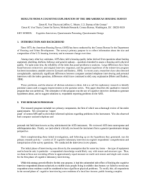
An official website of the United States government
Here’s how you know
Official websites use .gov
A .gov website belongs to an official government organization in the United States.
Secure .gov websites use HTTPS
A lock (
) or https:// means you’ve safely connected to the .gov website. Share sensitive information only on official, secure websites.
-
//
- Census.gov /
- Census Working Papers /
- Results From a Cognitive Exploration of the 1993 AHS
Results From a Cognitive Exploration of the 1993 American Housing Survey
Results From a Cognitive Exploration of the 1993 American Housing Survey
Introduction and Background
Since 1973, the American Housing Survey (AHS) has been conducted by the Census Bureau for the Department of Housing and Urban Development. The survey's primary purpose is to collect information about the size and composition of the U.S. housing inventory and to measure change over time.
Among many other key estimates, AHS data yield a housing quality index derived from questions about heating equipment, plumbing, kitchens, hallways and general upkeep -- questions intended to assess a housing unit's physical quality. For quite some time, the reliability of the index has posed problems to analysts. Large differences have been found between reinterview and original interview responses, and the general experience of the reinterview program has been inconsistent, unstable answers (Lessard and Bushery, 1993). In recent years, researchers have also detected unexplainable, statistically significant differences between computer assisted telephone interviewing and personal interviews with the index questions, differences which have continued to defy easy explanation (Meier and Bushery, 1994).
These problems, and the absence of obvious solutions to them, led to a call for exploratory research to identify potential causes and to suggest improvements to the question series. This paper describes the qualitative research program that was carried out. The centerpiece of this program was the use of cognitive interview methods to generate hypotheses about, and to suggest solutions to, respondent reporting problems in the AHS.
Others in Series
Working Paper
Working Paper
Working Paper
Share
Related Information
Some content on this site is available in several different electronic formats. Some of the files may require a plug-in or additional software to view.
 Yes
Yes
 No
NoComments or suggestions?


Top

